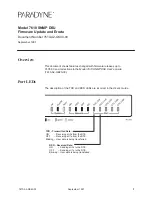
3Com Switch 8800 Configuration Guide
Chapter 48 RMON Configuration
48-1
Chapter 48 RMON Configuration
48.1 RMON Overview
Remote Network Monitoring (RMON) is a type of IETF-defined MIB. It is the most
important enhancement to the MIB II standard. It mainly used for monitoring the data
traffic on a segment and even on a whole network. It is one of the widely used Network
Management standards by far.
RMON is implemented fully based on the SNMP architecture (which is one of its
outstanding advantages) and compatible with the existing SNMP framework, and
therefore it is unnecessary to adjust the protocol. RMON includes NMS and the Agent
running on the network devices. On the network monitor or detector, RMON Agent
tracks and accounts different traffic information on the segment connected to its port,
such as the total number of packets on a segment in a certain period of time or that of
the correct packets sent to a host. ROMN helps the SNMP monitor the remote network
device more actively and effectively, which provides a highly efficient means for the
monitoring of the subnet operations. RMON can reduce the communication traffic
between the NMS and the agent, thus facilitates an effective management over the
large interconnected networks.
RMON allows multiple monitors. It can collect data in two ways.
z
One is to collect data with a special RMON probe. NMS directly obtains the
management information from the RMON probe and controls the network
resource. In this way, it can obtain all the information of RMON MIB
z
Another way is to implant the RMON Agent directly into the network devices (for
example router, switch and HUB), so that the devices become network facilities
with RMON probe function. RMON NMS uses the basic SNMP commands to
exchange data information with SNMP Agent and collect NM information.
However, limited by the device resources, normally, not all the data of RMON MIB
can be obtained with this method. In most cases, only four groups of information
can be collected. The four groups include alarm information, event information,
history information and statistics information.
The Ethernet Switch implements RMON in the second method by far. With the
RMON-supported SNMP Agent running on the network monitor, NMS can obtain such
information as the overall traffic of the segment connected to the managed network
device port, the error statistics and performance statistics, thereby implementing the
management (generally remote management) over the network.
48.2 Configuring RMON
















































